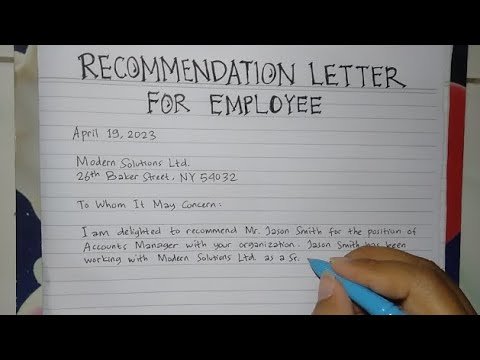How to
How to Write a Letter of Recommendation

Writing a letter of recommendation is a significant task that can influence the opportunities and future prospects of the person you’re recommending. Whether it’s for academic admissions, job applications, or professional memberships, a well-crafted letter of recommendation can open doors and make a substantial difference. This article aims to guide you through the process of writing an effective letter of recommendation, providing insights and tips to ensure your letter stands out and genuinely supports the candidate’s application.
Understanding the Purpose and Impact
Before diving into the mechanics of writing, it’s crucial to understand the purpose and impact of a letter of recommendation. Such a letter serves as a professional endorsement of the candidate, highlighting their skills, achievements, and character. It offers a third-party perspective to evaluators, adding credibility and depth to an application. The impact of a well-written letter can be profound, tipping the scales in the candidate’s favor by presenting them as a rounded, competent, and valuable addition to the program or organization they’re aspiring to join.
Getting to Know the Candidate
The first step in crafting an effective letter is to ensure you know the candidate well enough to write a meaningful recommendation. This involves more than a superficial understanding of their resume or academic record. Engage in a conversation with the candidate, asking them to share their goals, projects, achievements, and instances where they’ve demonstrated the qualities you’re planning to endorse. Request a copy of their resume, the job or program description they’re applying to, and any other documents they think might help you write a more informed letter.
Structuring Your Letter
A well-structured letter of recommendation follows a conventional format, typically one page in length, and includes the following elements:
- Introduction: Start with a strong opening statement that clearly states who you are, your professional relationship with the candidate, and your qualifications for recommending them. This sets the stage for the reader and establishes the credibility of your endorsement.
- Body Paragraphs: Dedicate one to two paragraphs to discussing the candidate’s skills, achievements, and qualities. Use specific examples to illustrate their capabilities and how they’ve effectively applied them in real-world situations. It’s also helpful to relate these qualities to the requirements of the position or program they’re applying for.
- Conclusion: Conclude with a strong endorsement of the candidate, summarizing their key strengths and reiterating your recommendation. Offer your contact information should the reader require further information or clarification.
Writing with Persuasion and Specificity
The effectiveness of a letter of recommendation lies in its ability to persuade through specificity. Vague praises do little to differentiate the candidate. Instead, focus on specific instances that demonstrate their abilities and character. Discuss how the candidate solved a challenging problem, contributed to a team’s success, or displayed exceptional leadership. The more concrete your examples, the more compelling your letter will be.
Tailoring the Letter
While it might be tempting to use a generic template, tailoring your letter to the specific application can significantly enhance its impact. Refer to the job or program requirements, and align your examples and endorsements with these criteria. This demonstrates your genuine support for the candidate and provides the evaluators with relevant information that can aid their decision-making process.
Professional Tone and Clarity
Maintain a professional tone throughout the letter, using clear and concise language. Avoid jargon or overly complex sentences that might obscure your message. Remember, the goal is to communicate the candidate’s merits as effectively as possible, not to showcase your vocabulary.
Final Touches: Proofreading and Submission
Before submitting the letter, proofread it carefully for any typos, grammatical errors, or awkward phrasings. Such mistakes can detract from the letter’s professionalism and the credibility of your recommendation. Ensure the letter is formatted neatly, follows any specific submission guidelines, and is sent within any given deadlines.
Conclusion
Writing a letter of recommendation is a responsibility that should be approached with care and consideration. By understanding the candidate well, structuring your letter effectively, and focusing on specificity and relevance, you can craft a persuasive and impactful letter that truly supports the candidate’s application. Remember, your endorsement can be a pivotal factor in their journey, and taking the time to write a thoughtful letter of recommendation is a valuable investment in their future.
FAQs on How to Write a Letter of Recommendation
1. How long should a letter of recommendation be?
A letter of recommendation should typically be one page in length. It’s important to be concise while still providing enough detail to give a comprehensive view of the candidate’s abilities and accomplishments.
2. Can I decline to write a letter of recommendation?
Yes, if you feel you cannot write a strong and positive recommendation for the person requesting it, it’s better to politely decline. Writing a lukewarm or negative letter can harm the candidate’s chances, so it’s more beneficial for them to seek a letter from someone who can fully endorse their candidacy.
3. What if I don’t know the candidate very well?
If you don’t know the candidate well, it’s advisable to have a detailed conversation with them about their goals, achievements, and the specifics of the position or program they’re applying for. Request their resume and any other relevant documents to better understand their background. If, after this, you still feel you cannot write a meaningful letter, it may be best to politely decline.



















